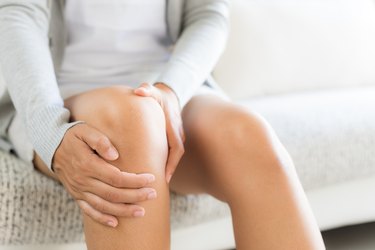
The inability to walk as far and as long as you'd like to can be frustrating and even depressing. If you aren't used to a lot of physical activity, this could be a normal response to increased exercise.
However, it might also be a sign your body is giving you to alert you of a health problem. Two medical causes of weakness in legs when walking a short distance may be spinal stenosis or peripheral artery disease, especially as you age.
Video of the Day
Video of the Day
Read more: How to Strengthen Weak Legs
Weakness and Spinal Stenosis
If your legs are tired after walking short distance, you could have spinal stenosis. This is a condition in which the opening that your spine passes through is narrowing, which causes compression on the nerve. If the portion of the spine that provides stimulation to your legs is affected, you may experience weakness, tingling or discomfort in your legs, particularly as you walk.
You and your doctor can decide the best course of treatment for your spinal stenosis, if you are diagnosed. Physical therapy is a healthy and safe option. A physical therapist can teach you exercises to maintain flexibility and range of motion to affected limbs. He can also provide exercises that help to open up the spinal column, which can ease your pain and make walking a more enjoyable experience.
Peripheral Artery Disease
Peripheral artery disease (PAD) may make it difficult for you to walk long distances. This condition occurs when the blood vessels that supply your leg muscles with blood and oxygen become narrowed. This makes it difficult to give your working muscles the nutrients they need, especially when you are using them, which can lead to pain and weakness of the muscle. Arteriosclerosis, or plaque buildup, causes the narrowing of your artery.
In addition to weakness, peripheral artery disease often causes calf pain when walking — a condition called claudication. This pain typically subsides after a few minutes of rest. PAD symptoms can also include cold lets or feet, shiny leg skin, weak or absent leg pulses and hair loss on the legs. See a doctor if you suspect you might have PAD.
Weakness in Legs When Walking
Physical activity may be enough to improve your symptoms. Your body may be able to adapt by finding a way to supply your muscles with blood by routing blood flow around the occlusion. Regular activity involving working to volitional fatigue, then resting until you are ready to work again, can help improve your circulation.
If your condition is beyond physical therapy, your doctor may recommend a more invasive course of action, such as surgery.
Exercise and Other Considerations
If you are generally a sedentary person, your leg weakness may just be from deconditioned muscles. According to the Centers for Disease Control and Prevention's (CDC) Physical Activity Guidelines for Americans, adults should perform moderate-intensity activities for 150 to 300 minutes per week, or vigorous-intensity exercise for 75 to 150 minutes per week.
The CDC also recommends including muscle-strengthening exercise at least twice a week. However, before you start exercising, always get medical clearance from your physician to rule out any underlying conditions that may be a cause of your leg pain when walking or problems during activity.
Read more: Nutrition for Tired Legs
Is this an emergency? If you are experiencing serious medical symptoms, please see the National Library of Medicine’s list of signs you need emergency medical attention or call 911.